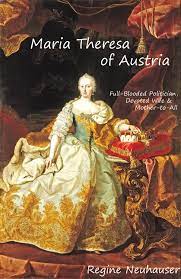Maria Theresa of Austria
The book I chose for the 2023 NONFICTION READER CHALLENGE in the category Memoir/Biography is Maria Theresa of Austria: Full-blooded politician, Devoted wife and Mother-to-all, by Regine Neuhauser, 2015.
This
book is a biography of Maria Theresa (Maria Theresia in German), ruler of
Austria and the Habsburg dominions from 1740 to 1780. The author writes in the
introduction, “The focus of this book is primarily on the human side of the
historical protagonists. This approach is to enable the modern reader to relate
to these long-gone people. To allow for an immediate reading experience, I
wrote the text in the present tense.”
There
were times when I found the use of the present tense confusing, but the historical
information is certainly written in a conversational and accessible style.
The
author seems to have great regard for her subject, but there isn’t much support
(in my view) for such admiration. Maria Theresa made very bad decisions
regarding the military, choosing people she liked or who had prestige for
strategic positions, rather than people who could get the job done. She also
seemed to have quite a vendetta against Frederick of Prussia (now known as
Frederick the Great), and many of her decisions – politically, militarily and
personally – seemed to be made with the intent of getting revenge on him. She
was also strict and overbearingly controlling with her children, famously using
them as pawns in the political marriage game.
However,
she managed to hold power for 40 years, when no woman was the head of state or
royal head of a country in her own right. She is said to have made many reforms
that helped ‘modernize’ Austria. But her son, Joseph II, who would be her
successor and co-ruled toward the end of her reign, tried to make many other
changes that would have been even better for the majority of Austrians, yet she
fought against those changes. For example, he tried to control the budget and
keep his mother from her lavish spending, but she refused to economize in any
way.
“She
considers it beneath her imperial dignity to bother with trifles such as
retrenchment and continues to happily squander Court allotments with lavish
generosity, for example by buying diamond-encrusted toys for her grandchildren
or rewarding her loyal and dedicated collaborators most generously with
palaces, pensions and paying their debts.”
The
organization of the chapters and material seems disjointed. Instead of writing
chronologically, Neuhauser structures each chapter around a particular topic.
For example, one chapter focuses on the marriages she arranged for each of her
children, but then in the next chapter there is a focus on events that happened
when most of the children were still young. This results in the jumping around
of events, and with each chapter I had to orient myself to when in time it took
place. It was also difficult to consider different events that were happening
at the same time.
Another
aspect that I found unsatisfying is that there are many examples of unclear
sources. For example, a quote is ascribed to Joseph II about his upcoming
marriage which he “…confesses to his lord chamberlain” and on the same page
there is another quote about the same topic he “…confesses to a confidant”. How
do we know this? Did these people (it seems they were two different people)
write a journal, write a letter, speak to someone else who wrote a letter?
There is a bibliography at the end of the book, but there are no notes,
footnotes or any kind of support at all.
For other readers, this might not be a problem as it was for me. A reader who wants to learn about the life of Maria Theresa of Austria and her role in the development of modern Europe, will find this an interesting read.


Comments
Post a Comment